|
 |
|
|
|
|
3rd Day (Tuesday, June 27)
Sightseeing Bus tour |
|
|
Got up at 6:00. Cloudy.
We have reservation of the following bus-sightseeing from morning today.
Visit Romantic Uji and Fushimi Area
Fucha Dish at Manpukuji, and Byodoin, Daigoji
We are going to leave Kyoto City today so as to see the sights in Uji and
Fushimi areas for 7 hours beginning at Mimurotoji, a temple of Hydrangea.
Our bus started at 9:40 with 20-odd guests on it from Karasumaru Exit of
Kyoto Station.
Hot and humid.
|
| - - - - - - - - - - |
| Mimurotoji Temple |
|
|
This temple is the 10th sacred place of the 33 temple Kansai Kannon Pilgrimage.
With Mt. Myojozan as its mountain name, Mimurotoji is a special head temple
of Honzan-shugen sect. It was opened in Hoki period (770-780).
We walked along the main approach to the temple surrounded by a grove of
Japanese cedar trees, and arrived at the Main Hall.
The present hall is said to have built in Bunka 2 (1805) as a multistoried
building with a gabled, hipped roof. Behind it, the main building of Isoha
Shrine (十八神社), and to the east the Bell Tower and Three-Story Pagoda.
|
|
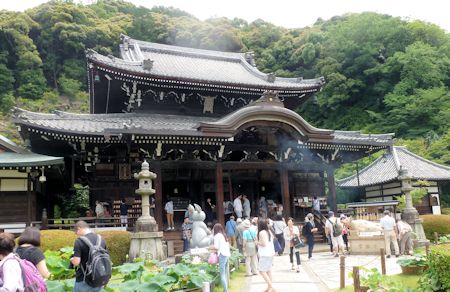 |
|
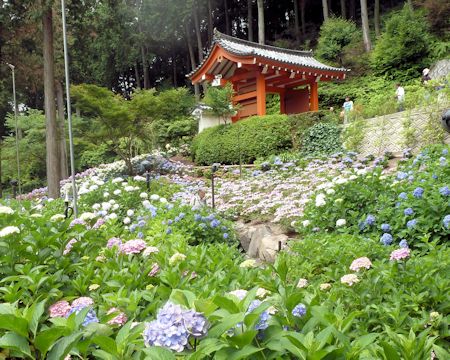
It is a temple of flowers, famous for the flower views of each season.
Around the gentle slope in the precincts there are two gardens, totally
5,000 tsubo (16,500 square meters), a garden of dry landscape and a garden
with a path around a central pond and spring. Hydrangeas are now in full
bloom. They are said to be counted to 10,000 plants, competing full bloom
from short of the gate toward the main hall. The colors are not only blue,
red and white, but various pale shades, all of which gave me a relief in
spite of myself.
|
I noticed a stone monument with Basho's haiku.
やまぶきや
宇治の焙炉の
匂ふとき
|
|
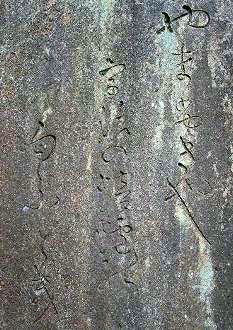 |
Also a tanka poem of Saigyo (1118-1190 from late Heian period to early
Kamakura period).
He was particularly adored by Basho (1644-1694 in early Edo period).
暮れはつる
秋のかたみにしばし見ん
紅葉散らすな御室戸の山
Truly, the precincts made me comfortable wholely.
Nearly one hour of refreshing was a good start of the day.
|
Whole picture of the temple
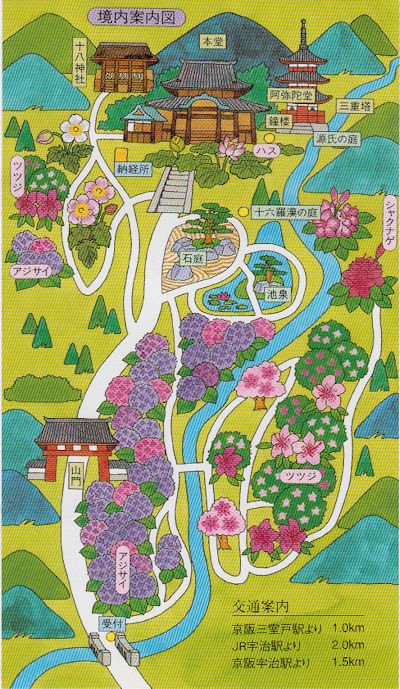
|
|
| Mimurotoji Temple, Other Pictures |
| - - - - - - - - - - |
| Manpukuji Temple |
|
|
The English Wikipedia explains what is Manpukuji Temple as follows.
| This temple is the head of the Japanese Obaku sect, named after Wanfu Temple
in Fujian, China. The mountain is likewise named after Mount Huangbo, where
the Chinese temple is situated.
The temple was founded in 1661 by the Chinese monk Yinyuan Longqi (Ingen)
and his disciple Muyan.
In 1664 control of the temple passed to Muyan, after many Chinese monks
followed as head priests. Only the 14th priest and his successors are Japanese.
The temple structures were constructed in Ming-China's architectural style.
The arrangement of buildings also follows Ming-Dynasty architectural style,
representing an image of a dragon.
The temple features an exemplary gyoban (fish board, used to toll the hours).
The temple treasure house contains a complete collection of Buddhist scriptures
completed in 1678 and comprising approximately 60,000 printing blocks,
which are still in use. The production of the printing blocks was funded
by donations collected throughout the country for many years.
The temple's main statue is a seated Gautama Buddha.
Sculptures by the Chinese sculptor known as Han Do-sei and latticed balustrades
can also be seen.
|
|
|
|
For the tourism purpose, Fucha food is the feature of this temple, I know.
But Fucha, what?
We arrived here before noon, and proceeded to the dining room from the
main hall through a corridor. There were several places I wanted to stop
at but I left them for the pleasure after lunch.
Guided to an ordinary room, we sat at the table with the following dish
on.
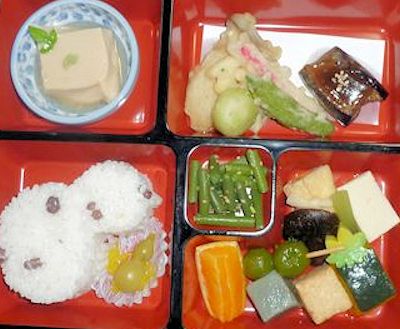 |
|
"Fucha" means to serve tea a lot of people widely. During the
meeting on the temple's events, the ceremony called "charei"
is held, and after that at the party "shacha"given in appreciation
of the service to the attendants they are served with Chinese vegetarian
food, which is called "Fucha".
(Manpukuji Temple's pamphlet) |
It was no doubt the Chinese vegetarian food. But I did not have any particular
impression. Emiko and the ladies admired it in their own way.
Contrary to the oracle of the above pamphlet, I did not feel any particular
difference from other temples, just like Fucha dish did not seem to be
a Chinese food both for my eyes and mouth. Shame on me.
|
|
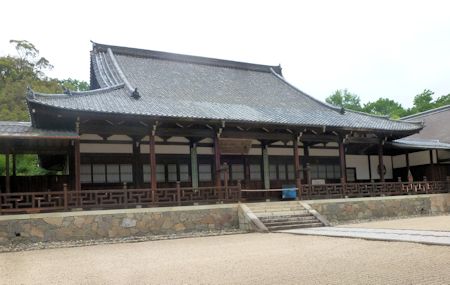
Main Hall (大雄宝殿)
A historical building built with teak material,
only one and largest in Japan. |
|
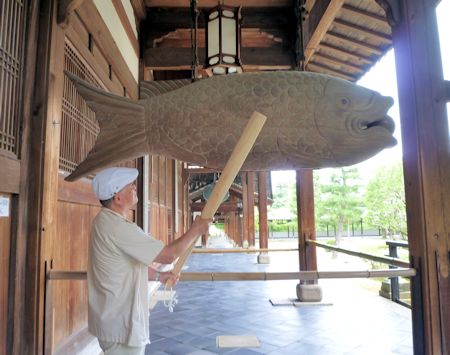
Kaiban (Gyoban) Board
The wooden board of fish shape
in front of Saido (a dining room),
used as a time signal now, too. |
|
|
|
The whole picture of the temple
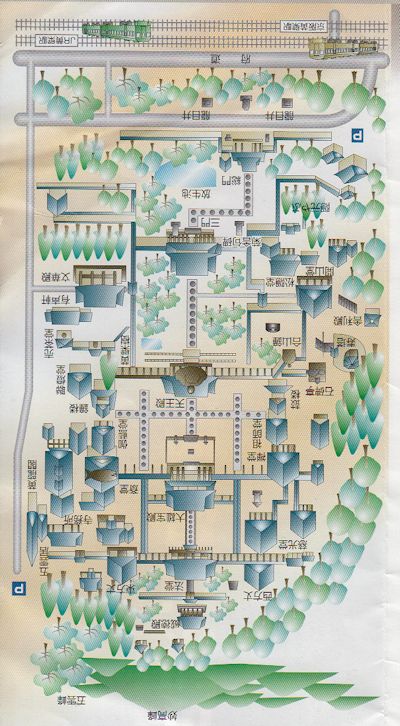
…………
山門を出れば日本ぞ茶摘み唄 (菊舎尼) |
|
| Manpukuji Temple, Other Pictures
Memo
Say "Priest Ingen" (隠元禅師), and I'll answer by the words "a
green bean". "Green bean"(インゲン豆) is a pun in Japanese.
According to a certain blog; Priest Ingen brought various cultural items here from China. A style of Chinese painting, mokugyo of Buddhist alter fittings, foods for famine like beans, lotus roots, thick-stemmed bamboo, watermelons. True or not?
The etymological dictionary on the Internet says; When Ingen, a priest
of Min (presently, China) moved to Japan in Sho-ou 3 (1654), he brought
green beans. It is the reason that a green bean is named "an Ingen
bean".
|
|
| - - - - - - - - - - |
| Byodoin Temple |
|
The following is what Byodoin Temple's pamphlet introduces itself, though
a little bit long..
| In 1052, the year which according to Buddhist beliefs was the first year
of the period of the decline of Buddhism, Fujiwara Yorimichi, who was then
the Kampaku (chief advisor to the Emperor), converted a villa of his father,
Michinaga, into a temple. This was the beginning of Byodoin Temple. This
era falls in the mid-Heian Period and was blessed with the dynastic culture
in its prime and the enhanced sense of beauty. In the next year, 1053,
the Amitabha Hall (national treasure) was built around the Ajiike Pond
in order to house Amitabha Tathagata. This is the Phoenix Hall, which was
elegantly and lightly designed to present the image of a many-storied building
as depicted in sutras.
The Ajiike Pond (modeled after the Treasure Pond on the Pure Land) extending
from the Phoenix Hall forms the temple garden, which is a historic place
of scenic beauty, famous as a masterpiece garden, with the grand landscapes
including the Uji River and the mountains far beyond that river. In the
early stage, many parts of Uji, a spot of scenic beauty, belonged to the
premises of Bydoin Temple and there were many halls and towers such as
the golden hall, the lecture hall, the hokke hall, and the treasure house,
as well as the Amitabha Hall.
The garden includes the Ogi no Shiba (fan lawn), which is famous as the
place where Minamoto Yorimasa committed suicide, the Kannondo (Avalokitesvara
Hall, important cultural property), the Temple-Bell Tower, and the Rakando
(Hexagonal Hall, designated by Uji City). The Suhama (sandy beach) has
been restored around the Phoenix Hall based on the available literature
and the excavations conducted. The Hirabashi (flat bridge), the Soribashi
(arched bridge) and Kojima (small island) have been built in combination
with the Suhama.
A number of cultural properties from the Heian Period remain in the Byodoin
Temple. Those historic heritages are diverse including the seated statue
of Amitabha Tathagata (national treasure), which is the sole work evidenced
to be created by Jocho, the best Buddhist sculptor in that period; the
existing oldest door paintings (aspect of Amitabha's epiphany, national
treasure); the Buddhist Temple-Bell (national treasure) famous as one of
the three best bells; the pair of Phoenixes ( national treasure); excavated
artifacts; Japan's oldest pilgrimage card and document.
Among them, the Fifty-two Worshiping Bodhisattvas on Clouds are national
treasures, which remains as the sole group of Buddhist statues from the
11th century. Each Bodhisattva rides on a cloud with a circular beam shining
behind its head. Some are playing musical instruments and others are holding
Buddhist artifacts; and some are making symbolic signs with the fingers
and others are joining their palms in prayer. All of them are sculptured
dynamically and elaborately.
|
|
|
| I have just noticed the back of 10-yen coin is the Phoenix Hall of Byodoin
Temple.
The true architecture is really with a dignified appearance different from
a ten-yen coin. Its whole view is similar to the shape of a big bird widening
its wings, and a pair of Chinese phoenixes on the roof of the central hall.
That is why it is called the Phoenix Hall.
It is Ajiike Pond that reflects the whole Byodoin view on the surface.
Byodoin Garden, a historical scenic spot, with Ajiike Pond in the center,
is a garden with the back mountains as borrowed scenery, and such as a
sand beach, a straight bridge and an arched bridge are arranged.
It was a magnificent scenery of different level from other temples and
shrines. |
|
|
Byodoin Temple, Other Pictures
|
| - - - - - - - - - - |
| Daigoji Temple |
|
It is a large temple with Main Hall (伽藍), Reiho Hall (霊宝館) and Sampo Hall
(三宝院). The five-story pagoda is the oldest building in Kyoto.
We came over 3 months ago when it was a fine weather and had a comfortable
worship, that time too. |
|
Daigoji is a Shingon Buddhist temple in Fushimi-ku, Kyoto. Its main devotion (honzon) is Yakushi.
It was founded in the early Heian period. In 874, Rigen-daishi (Shobo)
founded the temple.
After having fallen ill and abdicated in 930, Emperor Daigo entered Buddhist
priesthood at this temple. As a monk, he took the Buddhist name Ho-kongo,
and shortly thereafter, died at the age of 46. He was buried in the temple,
which is why his posthumous name was Daigo.
Several structures, including the kondo (Golden Hall) and the five-story
pagoda, are National Treasures of Japan. The temple possesses 18 specifically
designated national treasures, including the buildings and other works
as well, and the temple holds several dozen important cultural assets.
Wall paintings at the temple were the subject of academic research which
earned the Imperial Prize of the Japan 60, Academy in 1960.
As part of the "Historic Monuments of Ancient Kyoto", it was
designated as a World Heritage Site.
The five-story pagoda at Daigoji temple was built in 951 and is the oldest
building in Kyoto. It was one of few buildings to survive the Onin War
in the 15th century.
|
|
|
|
As many as 55 pictures of mine are linked together with the ones in late
March.
Each of the 3 areas seems to have its own characteristic, but I did not
pry into it.
Karamon Gate, the garden of Sampoin, Byobu-e (paintings on folding screens)
in Omote-shoin, Golden Hall behind Niomon Gate in Garan area, and Five-story
Pagoda on the right side.
This pagoda, completed in Tenryaku 5 (951), is the oldest wooden building
in Kyoto.
In Reihokan Hall just short of the exit there were lined a lot of Buddhist
statues of National Treasure and Important Cultural Asset. In last March
weeping cherry trees were beginning to come out around here.
Daigoji Temple, Other Pictures
Pictures at the Visit on March 28
|
|
| - - - - - - - - - - |
| Kajuji Temple |
|
|
With the mountain name "Mt. Kiko", Kajuji Temple is the main
temple of the Yamashina branch of Shingon sect.
This temple was built in Shotai 3 (900) by Emperor Daigo with Shoshun as
a founder. The principal image is Senju-kannon (Thousand-armed Avalokiteshvara
and the temple crest is Ura-Yaegiku. It has deep ties with Fujiwara clan.
The garden "Hyochien" is a stroke-style garden around a big pond
with enjoyable natural beauty. It has the landscape with "Himuro-no-ike
Pond" (a pond of ice room) in the center, the neighboring mountains
as borrowed scenery.
|
|
|
|
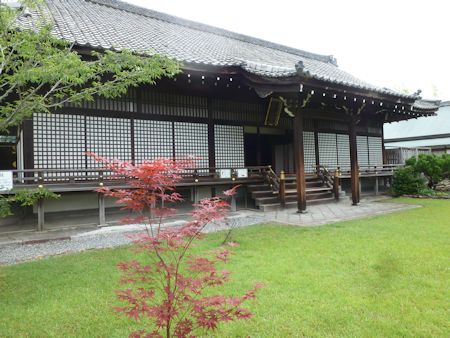
To my regret, I did not get any strong impression besides the pond (so-called
the pond of icehouse).
Kajuji Temple, Other Pictures
|
| - - - - - - - - - - |
|
On the way back from Byodoin, we saw Matsubara Bridge over Kamogawa River
through the bus window. The guide lady said, "Just a joke, but they
say this side here of Byodoin is a paradise and the other side across the
bridge is a hell."
According to her, there is a temple "Rokudo-chinnoji" just across
the bridge, which is nicknamed "Rokudo-san" by the local people.
The intersection before the temple used to be called "Rokudo-no-tsuji", which means the crossroads of the present and the next world. The JTB guidebook says "Old people had a custom to cross Kamogawa River carrying a coffin of a dead person and to have a priest's prayer for a departed soul around here."
Just to make sure, there are also temples for the paradise like Joruriji
Temple near there.
Why do I want to mention this story? Think of Kamogawa River as the River
Styx and Matsubara Bridge as the road to the next world, and it is the
stage of the rakugo (comic story) "Eight views in the hell and fun
of the dead" (地獄八景亡者の戯れ). The following is its outline from Wikipedia.
|
The story begins by the stage where Kiroku, died by food poisoning of raw
mackerel, meets an old retiree of Iseya again on the way to the underworld.
Crossing the Styx, the Children's Limbo, the crossroads of Rokudo and the
palace of Enma (King of Hell), ..., these familiar sights of the hell are
described with various characters one after another.
The first half is until Enma Daio makes various decisions to the characters
including Kiroku. In the result, four men have to go to the hell.
The second half is lined by the various interactions among the four men,
ogres in the hell and Enma Daio. The four are all suspicious fellows, who
trouble ogres by every possible means.
|
Once before, I was charmed with this rakugo of much over one hour played
by Katsura Beicho. The plot, characters with strong personality, a lot
of jokes, ..., it is exactly a superb piece of rakugo. I want to listen
to it again.
|
| - - - - - - - - - - |
|
|
|
|
|
|
|
|
|
|
|
|